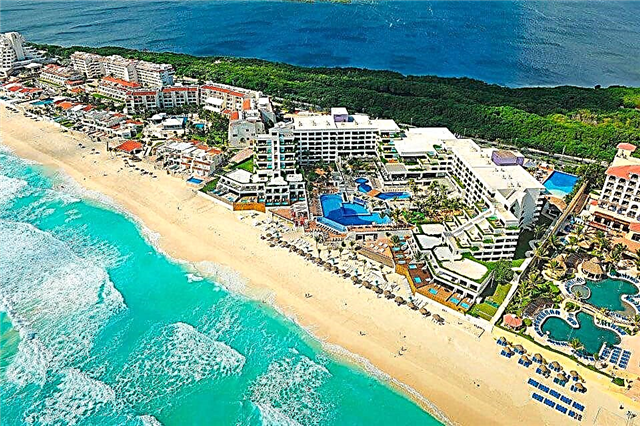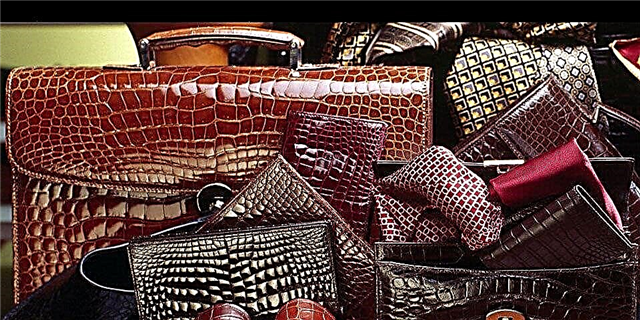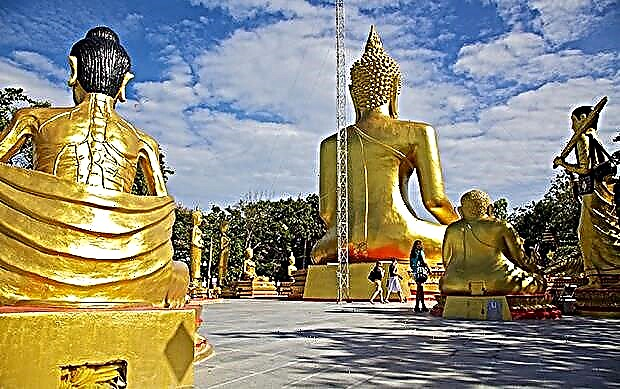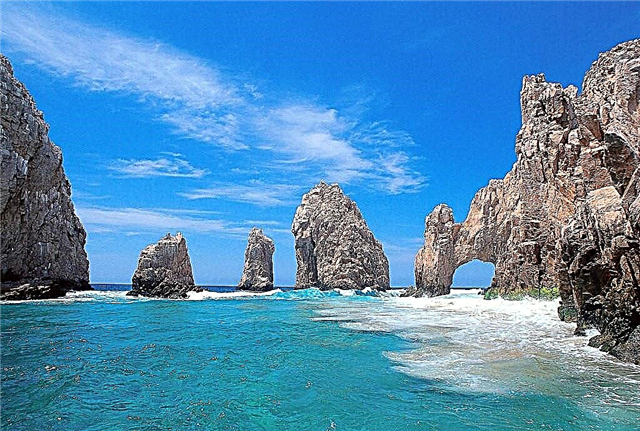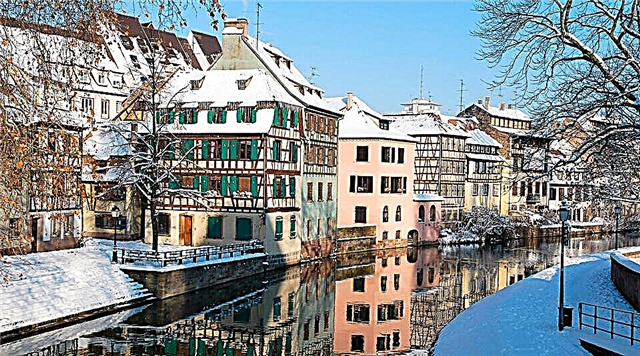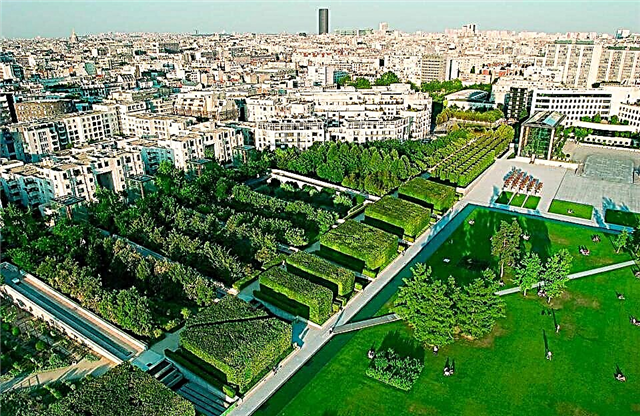In one of the most amazing cities in the world - the cradle of the French Revolution, the abode of talented people of art, many unique attractions are concentrated. The Eiffel Tower, Louvre, Montparnasse, and the Arc de Triomphe are known to almost every person on our planet. But, probably, such beautiful places as the parks of Paris, with the exception of the Champs Elysees, are not familiar to everyone. This article will briefly introduce you to the enchanting world of man-made and natural beauty, captured in the best parks in Paris. / P>
Tuileries Garden

The old park, which is located in the heart of Paris, has long won the love of many guests and indigenous people of the romantic city. The complex appeared back in 1564, becoming a kind of decoration of the palace of Queen Catherine de Medici. Since the mentioned person of royal blood belonged to the ancient Italian family, the "green" zone is made in the corresponding style, which gives this part of Paris a special charm.
For ordinary visitors, the park became accessible only after the French Revolution and has repeatedly undergone large-scale restoration after numerous artillery and air attacks during the two World Wars.

Today this unique landmark is considered a model of a true "French garden" and is a perfectly symmetrical project thought out to the smallest detail. And in many respects this was the merit of the brilliant landscape architect A. Le Nôtre. In the luxurious greenery of the park, the most beautiful sculptures of masters of all times are buried. The oldest work belongs to the 18th century. The sculpture by Auguste Rodin called "The Kiss" deserves special attention, which, like a magnet, attracts art connoisseurs from all over the world. There are also quite recognizable sculptures, which in fact turn out to be good copies of the originals.

In the western part of the park there is an art gallery, which displays the best works of the Impressionists and other popular artists. Here, by the way, there is a magnificent painting "Water Lilies" by Claude Monet. But the northern wing of the park is dedicated to contemporary trends in art.
Louvre: Time-Specific Entry Ticket
1-hour cruise "Lights of Paris"
Skip-the-line tickets to the roof of the Arc de Triomphe
Eiffel Tower: Second Floor Access
Versailles & Gardens: Skip-the-Line Entry Ticket with Audio Guide
Hop-on Hop-off Bus Tour. Class., Prem. or Lux
Paris museums subscription: 2, 4 or 6 days
Tickets for Montparnasse: 56th Floor Roof Terrace
Show at the Moulin Rouge with champagne
Field of Mars

This park complex belongs to the most famous French "green" areas. It is located at the very foot of the symbol of Paris - the Eiffel Tower. The uniqueness of this attraction is hidden in its practical purpose. The Field of Mars itself is a parade ground where students and teachers of the nearby Military School are trained.
Over its centuries-old history, the field has repeatedly become the site of key historical events that have left their imprints on the history of both Paris and France. For example, it was here that a balloon with the notorious explorer Blanchard came off the ground, the revolutionaries shouted their mottos, and in the century before last, the field generally became the venue for horse races.

The square is a favorite vacation spot for indigenous people and guests of the capital, who often visit these places with a blanket, a bottle of their favorite wine and fresh cheese. Even at night in the park, you can see numerous lovers who simply sit in the company of burning candles and enjoy the marvelous landscapes of the Parisian tower. By the way, from 8 o'clock in the evening the grandiose building becomes a real theater of illumination, so that the atmosphere turns into an emphatically romantic one.
Bois de Boulogne

In the western part of Paris, there is another square of grand scale and captivating with its amazing landscapes. Among the townspeople, the forest is known as the "western lung" of Paris. Several centuries ago, this place was a huge oak grove called Rouvray, in which hunters from the royal family and nobility loved to spend their time so much. Today, a well-groomed massif is spread here, on the territory of which you can get acquainted with a lot of interesting places and sights.

Most visitors to the "green" zone begin their acquaintance with the architectural masterpiece Bagatelle, which has a gorgeous rose garden. The history of the creation of the palace is also unique. If you believe the primary sources, then it was built in just two months, for which almost a thousand workers worked on the masterpiece project day and night. This was precisely the condition of the dispute between the Count d'Artois and his brother's wife, Queen Marie Antoinette, from which it was the Count who was able to emerge victorious.
Today, you can get acquainted with the rich decoration of the palace for only 6 euros.
La Villette park

The park complex La Villette is a unique theatrical platform, the main character on which is nature itself. In the 19th century, this place was considered the largest "green" complex in the French capital, and today it represents an interesting combination of past and present, appears in the light of architectural masterpieces and industrial projects. Themed pavilions are scattered everywhere, which are quite popular with tourists. Well, for lovers of pristine nature, walks along the Urk canal, which divides the park into two zones, will have a taste.

On weekends and on holidays, the park hosts entertainment and cultural events, including numerous exhibitions, theatrical performances, music concerts and even evening movie screenings right in the fresh air! The southern part of the park, where the town of science and industry is located, deserves special attention. By the way, this particular cultural center is one of the three most visited entertainment venues in Paris, second only to the famous Louvre and the Pompidou Center.
Flower garden

Well, how can you ignore the favorite square of all Parisians? Several pavilions are located on a huge territory, each with its own special microclimate. And the entire territory of the park is generously strewn with millions of various flowers - from tulips to peonies, from daffodils to poppies. You can even admire the miniature Japanese-style trees here.
Interestingly, the French garden was designed in the likeness of Japanese flower gardens. In it, one varieties of plants are replaced by others, third, and so on. It will take more than one hour to get around all the pavilions, which occupy an area of more than 6 hectares. It is after the acquaintance with this place that the last doubts disappear as to why France is considered the most flower country in Europe.
France in miniature

Paris is able to surprise not only with unsurpassed masterpieces of the past, but also with modern objects that are a real miracle. These include the amazing park "France in miniature", a visit to which will give a complete picture of the whole country. The idea of creating an entertaining and informative France in miniature originated in 1991. 160 iconic landmarks (miniature copies), located on an area of 5 hectares, amaze with their one hundred percent similarity to the originals.
Dan Olman, a talented craftsman, master and artist, architect and sculptor in one person, worked on the creation of unique copies for the mini-country.On the green carpet of lawns, between islets of shrubs and trees, the French provinces are represented: Gothic Flemish, wine-making Burgundy, seaside Brittany, the majestic and romantic Basque Country, etc. In half an hour you can see France from the Eiffel Tower to Fort Bayard. An unforgettable experience will remain from visiting the stunning entertainment attractions, concentrated in different "regions" of the micro-country.
Park "Asterix"

The French are known as a nation that can work hard, provide talented creators and have great fun. It is no coincidence that there are many entertainment places in Paris, including the modern Parc Asterix, named after the beloved hero of French comics. The creation of attractions (30 of them), located in 5 thematic zones, is based on adventure stories from the stories about Asterix and Obelix. For example, an attraction-journey along a conventional river flowing along the Gallic settlements, where the legionaries of Rome were defeated.
Visitors of all ages will find entertainment here to suit their interests. In addition to the rides, the park hosts theatrical performances that capture the imagination. In the large central tent, a hot battle between the "Gauls" and the "Romans" unfolds every hour, leaving no one indifferent. Spectators of dolphin aquatic performances admire the display of extraordinary abilities in performing all kinds of tricks by these intelligent mammals. A visit to the Asterix Park is a lot of positive emotions.
Disneyland

The most visited object in Paris - Disneyland, which is a branch of the American entertainment complex, is located on 1943 hectares. This truly fabulous country, where every child dreams of going, is located 32 km from Paris. Fantastic rides, amazing playgrounds, Disney characters turn a visit to the park into a magical exciting journey into an amazing world. Sleeping Beauty Castle, Snow White and the 7 Dwarfs, Robinson, Jack Sparrow, Captain Nemo's Nautilus - whoever you will not see among the inhabitants of Disneyland.
Here you can feel yourself in the role of Indiana Jones, riding on a swaying decrepit trolley; wander in the labyrinths of Wonderland with Alice; feel the bright flavor of the Aladdin East; find yourself in Robinson's hut. Everyone is breathtaking from being in the Wild West sector, with "gold mines", pistol shooting and extreme roller coaster ride "Thundering Mountain". Many unexpected and interesting things are revealed in the entertainment empire - Disneyland Park.
Aquabulvar water park

Not every European capital can boast of such a large-scale water entertainment center like the Aquaboulvar water park in Paris. The industry of dizzying water attractions, created almost in the city center, covers an area of 7 thousand square meters. m. In the closed part of the water park under glass, a constant temperature of water and air (29 °), which creates a comfortable environment for visitors. There is a large selection of pools: for "walruses" there are pools with cold water, a pool with artificial waves, with sea water.
There are beautiful open beaches, real tropical oases with palm trees, lianas and pacific vegetation. The abundance of attractions amazes with the number and variety: water slides for children of different ages, mini-waterfalls, fountains, geysers, bubble baths, streams with a countercurrent, etc. Teenagers are especially fond of water cannons, from which they "fly out" and plunge into the water, imitation of surfing. The 30-meter Blue Whale, invented by the famous explorer of the sea depths I. Cousteau, delights children. Entrance to the water park is allowed for children from 3 years old.
Luxembourg garden

Truly sacred for the French, an atmospheric place where Parisians of any age love to be - the Luxembourg Gardens was founded by order of the famous Queen M. Medici in 1611. It arose around the Luxembourg Palace, which was built and received the same name. Garden, spread out on the square. 26 hectares is a corner of Florentine culture on Parisian soil, many features of which have survived from the 17th century, for example, a ramp with terraces, a large fountain, layout, some sculptures, etc.
The magnificent ensemble of beautiful architecture and flora is a wonderful decoration of the capital, where it is always full of people, remembers the names of the greats of this world, who considered it their duty to visit this corner of man-made beauty. Everyone is captivated by emerald lawns with brightly framed flowers, shady trees, various concerts held in a music pavilion with an open stage. There are sports and playgrounds, interesting attractions and a special atmosphere that awakens bright nostalgic feelings.
Parc Buttes-Chaumont

If we translate into Russian the rather beautiful-sounding name of the Buttes-Chaumont park, then it will become very prosaic - "bald mountain". Even more prosaic and gloomy is the history of the place where this wonderful park is now laid out. In the 18th century. there was a fetid dump of horse and human corpses here, so the Parisians immortalized the name of Baron Haussmann, who risked as mayor of the city, to turn the terrible place into a public park.
In 3 years, all the garbage was removed, a multi-kilometer road was made, terraces, lawns and flower beds were laid out, thousands of expensive trees, exotic shrubs, and ornamental plants were planted. The originality of the park's layout is due to the height difference, which gives it a special charm. There is a lake with a small island, on a 50-meter rock of which the Temple of Sibylla was built. A suspension bridge (63 m) and a stone one, nicknamed "the bridge of suicides", leads to it. Visitors will find many interesting "highlights" in this natural and man-made paradise.
Park Montsouris

Another brainchild of Baron Haussmann, created on the site of a former quarry in the southern part of the city, the Montsouris park was opened in 1869, although the improvement continued until 1878. The same specialists worked on its creation as in the Buttes-Chaumont park, who overcame many difficulties in the design and implementation of the idea. A huge artificial lake was dug among the hills with an artificial stream flowing into it, limited by a picturesque stone cascade.
Ladders and lawns were laid along the hillsides, a network of winding paths and paths was formed along the territory, trees and bushes were planted along them. Today, Montsouris Park is the embodiment of recreated natural beauty, against the background of which dozens of entertainment facilities function: various pavilions, a theater, concert venues, and fascinating attractions. During the day, there are always many visitors of different ages, and each of them finds something special for himself.
Bois de Vincennes

In the east of Paris, a huge green area (995 hectares) stretches the Bois de Vincennes, which has now become a popular holiday destination for Parisians. Back in the 10th century, when G. Capeta was in power, a royal hunt was organized in the forest, so it was surrounded by a fence, a hunting lodge was built in it, which later turned into a luxurious castle. Under Napoleon III, they began to actively ennoble the territory: they equipped paths, fountains, installed sculptural compositions, formed artificial lakes.
It is impossible to inspect the Vincennes park complex at one time. Its main attraction is the royal castle, around which the town of Vincennes has already grown. To the south of Lake Domenil attracts the attention of the Buddhist Pagoda (1932), with a massive gilded statue of Buddha located in it. Here you can go boating on the lakes, ride bicycles, walk among the irresistible landscape paintings, visit the butterfly garden, the historical redoubt of the 19th century. and just get some fresh air.
Botanical Garden

When you come to the Parisian Botanical Garden, you cannot believe that such a riot of diverse flora is located in the city center. Here on pl. in 30 hectares, you can get acquainted with a variety of climatic zones, with typical plants for them (there are more than 1,000 species in total). The botanical garden was opened in 1926 at the initiative of the royal physicians, who considered it necessary to visually acquaint students with medicinal herbs and flowers.
Now it is a grandiose scientific and educational institution in the open air, in which there is nothing: thematic greenhouses, a mineralogy gallery, a rosearium, an Evolution gallery with stuffed dinosaurs, an Alpine garden and even a menagerie. Children especially like the spiral road - the Great Labyrinth leading to the top of a hill formed in the 14th century. from limestone and debris. There is an original gazebo made of metal parts, which is considered the oldest metal structure (it appeared 100 years earlier than the Eiffel Tower).
Belleville park
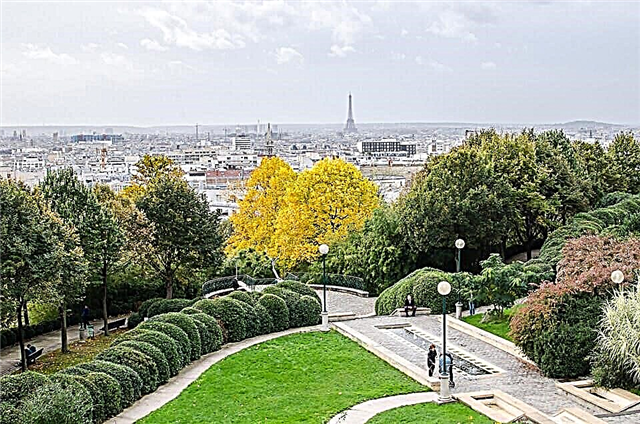
On a high hill in the Belleville quarter (formerly a village) there is a park of the same name, which has preserved a vineyard and a winery within its boundaries from the former village. But this wonderful corner of Paris is truly famous for its picturesque terraces and the longest cascading fountain. By the way, there are many fountains here, and each of them has its own "zest". Neat paths, beautiful lawns with flower beds, originally trimmed arrays of shrubs create unique landscape landscapes. Against their background, you can have a wonderful rest, admiring the magical panorama of Paris from above.
An open-air theater operates here, where performances are held almost daily. The ecological pavilion "House of Air" is interesting for visitors, where exhibitions are organized that tell about measures to combat air pollution. On them, everyone will learn a lot of new and vitally important things about the meaning of the earth's atmosphere, the composition of the air, etc.
Fonteblo Palace and Park

A unique architectural structure - the Fontebleau Palace is not only a kind of masterpiece of architecture that embodied several styles in its appearance, but a monument to the history of the French kings. Transformed under Francis I from the abode of hunters into a luxurious palace, Fontebleau underwent many changes under Henry IV and Napoleon Bonoparte and became the cradle for subsequent royal dynasties.
In the mixed architecture of the majestic palace, Gothic austerity, the symmetry of the classics and the luxury of the Renaissance are intertwined. The example of the latter is the Holy Trinity Chapel, whose interior decoration amazes with splendor and beauty. The park surrounding the palace has also changed over the years, acquiring an ever more colorful appearance. It is impossible not to admire the green squares of lawns, bright floral patterns, amazingly shaped cypresses, clean ponds and fountains.
Bagatelle Park

In one of the cozy corners of the Bois de Boulogne, there is a true masterpiece of landscape and park art - Bagatelle Park, whose name means "trifle". It is connected with the history of the appearance here in 1777 of an elegant classical palace, the construction of which in a short time the Count d'Artois considered a trifle. Satisfying his ambition with the work of 900 workers around the clock, the king's brother ordered to plant a garden in the English and Chinese styles around the new palace.
The project of a wonderful garden (architect Belange) provided for a lake, a river, cascading waterfalls, grottoes and bridges, sculptures and fountains. A Scottish gardener worked on the implementation of the landscape project for 10 years. The infamous Queen Marie Antoinette admired the extraordinary palace and garden and lived here until her execution. After a grandiose reconstruction during the reign of Napoleon III, a magnificent rose garden was laid here, which is still admired by tourists from all over the world. Now 9 thousand rose bushes are blooming in it, and the "Most Beautiful Rose" competition is being held.
Versailles palace park

Just as the Palace of Versailles itself is the standard of a solemn country residence, so the surrounding park is an unsurpassed example of a landscape miracle, the beauty of which is impossible to resist. Now this palace and park complex is the true wealth of France, honored to take its rightful place in the UNESCO list. A visit to this landscape piece of art is a surge of emotion and mute delight when words are superfluous.
Looking at all this splendor: lawns, flower beds, terraces, fountains, pools of unusual shape, you cannot believe that such beauty can be created by hand. It took almost 4 centuries to transform the once remote province into one of the most splendid places in Europe. How not to recall the most pretentious of the French monarchs, Louis 14th, the "Sun King", under whom the palace was expanded and the park was improved. Of course, one cannot forget the merits of his successors, who not only saved the great heritage, but also significantly developed it.
Andre Citroen Park

The Seine Coastal Park is a special kind of park, built on the site of the former Citroen car factory in 1991 and named after the founder of the famous car brand. Its central part is a grassy lawn, around which amazing objects are concentrated. The creators of park structures put a cognitive and philosophical meaning in them. Here the elements of entertainment are associated with learning new things.
Between 2 greenhouses, where you can see the flora of the Mediterranean and the tropics, there is a kind of entertainment area with "dancing" fountains, along which children love to run under the unexpectedly erupting streams of water. There are 8 thematic gardens organized here: Black (with dark-colored plants) and White (with light-colored flora), Blue, Red, Gold, etc., each of which has a symbolic connection with a certain phenomenon or substance. An interesting and fascinating world opens up to the visitors of A. Citroen's park.
Bercy Park

A small right-bank part of the Seine (13.9 hectares) in the 12th arrondissement of Paris, designed as a public park of Bercy on the site of a winery - the merit and project of the famous French President Mitterrand. The 10th largest Parisian park has a glorious historical foundation - in its place there were vineyards, a winery, producing delicious royal wines. In the magnificent appearance of the landscape and park structures, retro features of the remarkable past and interesting elements of modern Art Nouveau have been preserved.
There are preserved relict age-old oaks, chestnuts, maples, lindens, authentic buildings of a wine-making village, paths paved with mighty cobblestones, along which graceful modern pavilions are installed. As a memory of the past, there is a greenhouse, a fruitful garden and even a vegetable garden with funny scarecrows. The sports and entertainment complex is a striking example of modernity - it is very interesting for the interior design and the varied program of its establishments. The park is loved by fans of roller skating, football games, picnics.
Use the services of kiwitaxi and at the airport, at the specified time, the driver will be waiting for you, help with the luggage and promptly take you to the hotel. Several car classes are available - from economy to Minibus with 19 seats. The price is fixed and does not depend on the number of passengers and the address within Paris. A taxi from / to the airport is a convenient and comfortable way to get to your destination.

